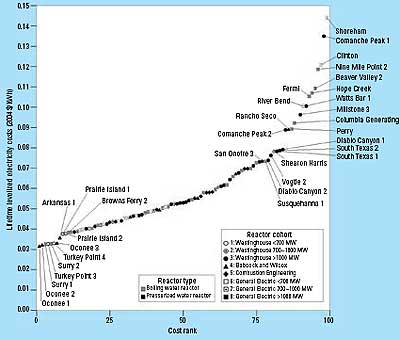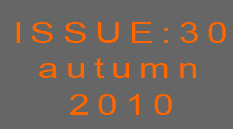
French and American nuclear history under the spotlight

by Andrew Teller
As for many other large-scale human endeavours, the deployment of nuclear power plants has attracted interest from an historical point of view. But in contrast with most other industrial undertakings, the motivation behind such inquiries is not just to take stock of the progress made, but the hope to find in the past some general trends that could serve as a predictor of future behaviour. Three recent papers attempting to achieve this have attracted my attention. They were published by Nathan E. Hultman, Jonathan Koomey and Daniel Kammen1 [HKK for short], Arnulf Grubler2 [AG] and Mark Cooper3 [MC] in chronological order.
Aside from the history, these papers also offer an interesting story. Their common purpose is to draw attention to the nuclear industry’s weak point, i.e. its tendency to exceed construction time and budget. At the same time, they show that the commonality of purpose can nevertheless lead to papers differing widely with respect to the quality of the work performed. We’ll briefly summarise each of them and see that the quality of the research is heavily dependent on the extent to which it is ideologically driven.
The argument of HKK is quite simple. The authors went through the painstaking task of assessing the busbar cost of almost all US nuclear power plants in operation and ranked them according to increasing kWh cost, which gives rise to the following chart:

Without even delving in the details of the figure, it can be easily seen that the slope of the upper quartile (the right-most points) is noticeably steeper than that of the first three quartiles. If we take 80 USD/MWh (2004 value) as a cut-off value, a full 16% of the units represent a financial risk higher than what would be expected if the costs followed a normal distribution. The moral they draw from this observation is that the same could well occur again in the future when the construction of Generation IV reactors will be considered. HKK recognise however that the factors behind the general cost increase highlighted by the above figure include the lack of standardisation, public opposition and an increasingly demanding regulatory context. The role of the last of these factors is clearly acknowledged in the paper published in Energy Policy, e.g.:
Construction duration in the historical sample was influenced by a complex set of interrelated factors, including rapid regulatory changes (both before and after the Three Mile Island accident), quality control problems in construction, increased reactor size, reduced electricity demand growth, and utility financial constraints (…). (p 5634)
On the other hand, the authors point out that some vendors claim that future generation III reactors cost will be very low, actually low enough to equal or beat the best performing of the present reactors. Nobody can blame HKK when they consider that this cannot be done without further justification. Past performance is not bound to repeat itself in future but provides good enough a reason for explaining why things will be different next time. In the context of this observation, one might regret that HKK did not try to investigate further the case of the outliers their work highlighted. It might so happen that the circumstances that gave rise to them will indeed not apply in future (e.g. the US NRC’s new licensing procedures). In such case, the whole reasoning could have been made on an historical record from which the “fat tail” would have been removed and the conclusions might have been altered.
The tone of AG is at first deceivingly friendly since it starts with a positive appraisal of the French programme. But this is only an opening gambit to reinforce a much less positive conclusion: the French programme has been successful, but mainly so when you consider its initial phase corresponding to the construction its 32 first 900 MW units on the basis of an American licence. According to AG, everything started going awry when the French decided to increase the power of their units and to “frenchify” the design. AG goes even further by asserting that, in our changing world, the factors that permitted the past successes will not repeat themselves. The pro-nuclear reader would counter that the steady increase in design power that does indeed characterise the French programme goes hand in hand with a stiffening of the safety impositions of the regulatory authorities. But AG has foreseen the argument (p 27):
The reactor design changes undeniably improved safety features (…). But that was never a prime motivation for the changes in design and is therefore unlikely to be a significant factor in the cost escalation compared to the much more drastic and cost-consequential design changes aimed at [furthering the interests of the French players]. (Italics are mine)
Please note the presence of the words “never” and “therefore” in the excerpt quoted. The first of them goes against the evidence available everywhere: more stringent safety measures entail much more pervading design changes than does an increase in nominal power. The second word highlighted is conveniently introduced to convey a sense of necessary connexion between design motivation and its cost. This is tantamount to saying that, if improved safety is not a prime motivator for design changes, then the latter cannot be expensive. This is no more than idle speculation: which safety authority would tolerate vendors’ skimping on the safety measures it imposes? On the contrary, the veterans of the nuclear industry have witnessed that, at least from the 1970’s onwards, power increase was seen as a way of stemming the cost increases linked to ever more stringent regulatory requirements. In case the pro-nuclear reader had not yet absorbed the message, AG reinforces his point (p 32):
(…) while the nuclear industry is often quick to point at public opposition and regulatory uncertainty as reasons for real cost escalation, it may be more productive to start asking whether these trends are not intrinsic to the very nature of the technology itself: large-scale, lumpy, and requiring a formidable ability to manage complexity in both construction and operation.
I would like to suggest the following compromise: let the nuclear industry investigate more thoroughly the actual applicability of the law of economies of scale to the construction of nuclear reactors and let the critics of nuclear energy start considering the historical trend followed by nuclear safety regulations.
MC draws on HKK and, much more heavily, on AG to make his own case. The fact that he pursues AG’s denial of the impact of regulatory constraints to its logical conclusion shows in the way he performs a statistical analysis of the available cost figures relating to the French and American fleets of reactors. He submits a model (p 25) where the explanatory factors are supposed to be the reactor (model), the industry, the builder, and the construction period, all impacting the reactor cost. Some of these factors are further broken down to yield 10 different variables which are used to perform a regression analysis of NPP cost. Having performed the exercise, MC appears quite happy to state (p 27) that
“(…) there is little support for the learning and scaling up hypothesis at the industry level”.
No wonder: if you don’t leave any room in your model for regulatory requirements and public opposition, don’t expect to find any impact thereof in your results. In addition, the whole idea of explaining everything through regression analysis betrays in MC a kind of blind faith in figures. Forecasting the future appears to be only a matter of crunching numbers. The matter investigated is taken as a black box with the past as input and the future as output. Such approach reminds one of the Greek tragedies in which the protagonists could not escape a foretold destiny. Wouldn’t a look at the internals of the box really provide any useful insight? As to the absence of relevance of public opposition and changing rules of the regulatory game, both AG and MC should know better. The impact of these forces in the United States is well documented, not least by AG and MC’s own ideological friends who, in the 1960’s and 70’s were proudly recounting the legal battles the anti-nuclear were waging against the designs of the industry. In those days, it was a matter of showing how the little guys managed to successfully counter the moves of the big industry. Today, the priorities have shifted: the ideological stance consists in overlooking the fact that this ever happened so as to suggest that the nuclear industry’s purported woes are solely of its own making.
The lessons of the foregoing are quite straightforward:
On the one hand, the nuclear industry would do well to revisit its past record to better understand what is ascribable to increasingly stringent safety rules and what is not. This would enable it either to confirm its “moving target hypothesis” or to introduce into its cost models the factors, so far unaccounted for, that might counteract the hoped-for economies of scale.
On the other hand, we find one more time that the anti-nuclear are happy to settle for lame arguments and/or poor methodology. This brings us back to the eternal question: if one has good reasons for advocating a certain position, why should one resort to bad ones?
Andrew Teller
12 October 2010
1What history can teach us about the future costs of U.S. nuclear power, Environmental Science and Technology, April 2007. This article, available on the Internet, is a companion publication to a research paper titled “A reactor-level analysis of busbar costs for US nuclear plants, 1970–2005”, Energy Policy, 2007, which is not freely accessible.
An assessment of the costs of the French nuclear PWR program 1970 – 2000, Interim Report, International Institute for Applied Systems Analysis, October 2009; available on the Internet.
3 Policy Challenges of Nuclear Reactor Construction and Crowding Out alternatives, subtitled Lessons from the U.S. and France for the Effort to Revive the U.S. Industry with Loan Guarantees and Tax subsidies, Institute for energy and the Environment of the Vermont Law School, September 2010; available on the Internet.
|

